An Analysis of Process Design and Effectiveness for Lidl Supermarket
VerifiedAdded on 2020/03/04
|9
|2502
|37
Report
AI Summary
This report provides a detailed analysis of Lidl's process design, focusing on the implementation of augmented reality and QR codes to enhance the customer experience and improve operational efficiency. It examines the effectiveness of these technologies in creating virtual supermarkets, streamlining the shopping process, and reducing environmental impact. The report explores the objectives of this design, including stages of service, impact of performance objectives, and environmentally sensitive design considerations. It discusses how Lidl aims to leverage technology to minimize waste, offer convenience through virtual shopping, and optimize its supply chain. The report highlights the potential benefits of these innovations, such as reduced costs, improved customer engagement, and enhanced sustainability, while also considering the challenges and constraints associated with their implementation. Ultimately, the report provides insights into how Lidl is adapting to the evolving retail landscape through innovative process design.

report
Paraphrase This Document
Need a fresh take? Get an instant paraphrase of this document with our AI Paraphraser
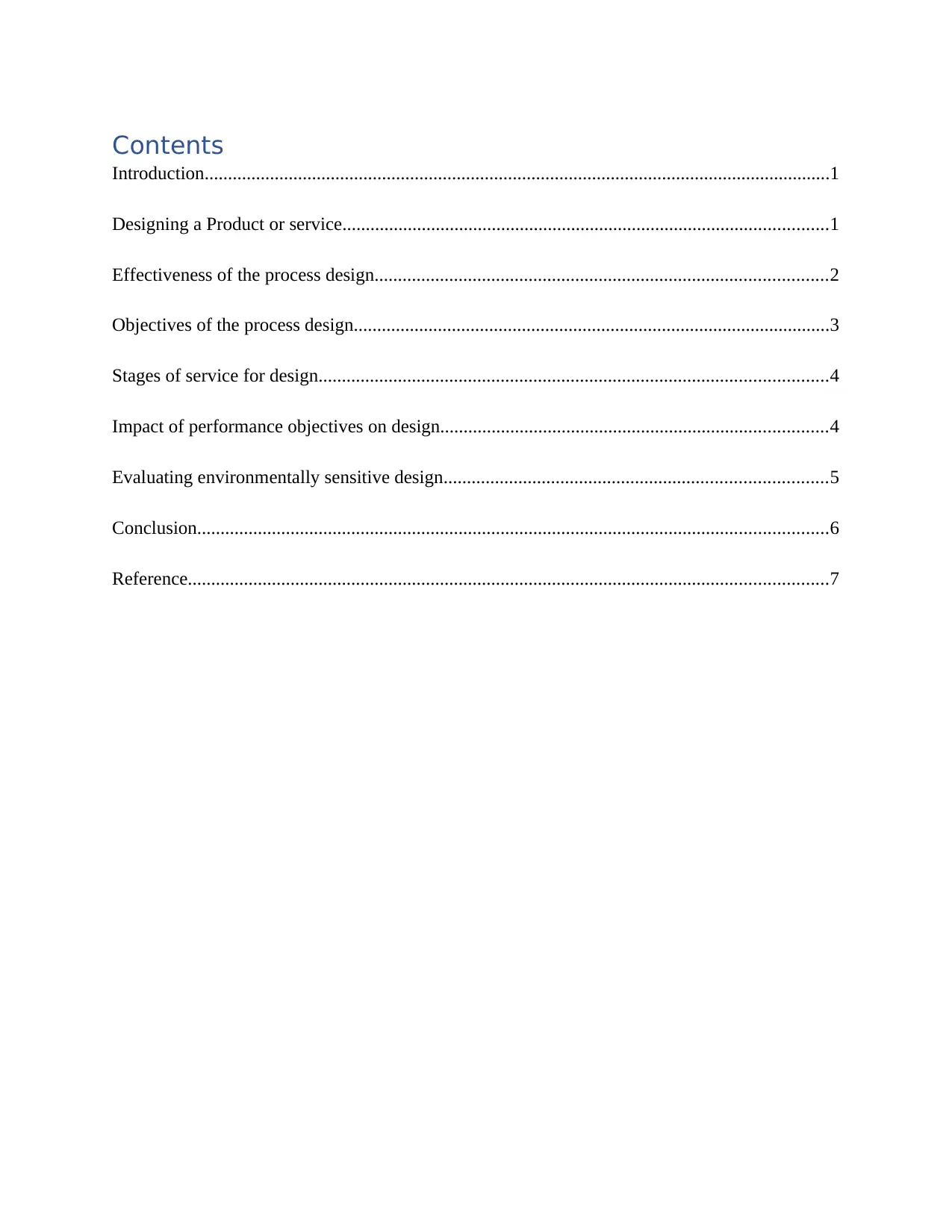
Contents
Introduction......................................................................................................................................1
Designing a Product or service........................................................................................................1
Effectiveness of the process design.................................................................................................2
Objectives of the process design......................................................................................................3
Stages of service for design.............................................................................................................4
Impact of performance objectives on design...................................................................................4
Evaluating environmentally sensitive design..................................................................................5
Conclusion.......................................................................................................................................6
Reference.........................................................................................................................................7
Introduction......................................................................................................................................1
Designing a Product or service........................................................................................................1
Effectiveness of the process design.................................................................................................2
Objectives of the process design......................................................................................................3
Stages of service for design.............................................................................................................4
Impact of performance objectives on design...................................................................................4
Evaluating environmentally sensitive design..................................................................................5
Conclusion.......................................................................................................................................6
Reference.........................................................................................................................................7
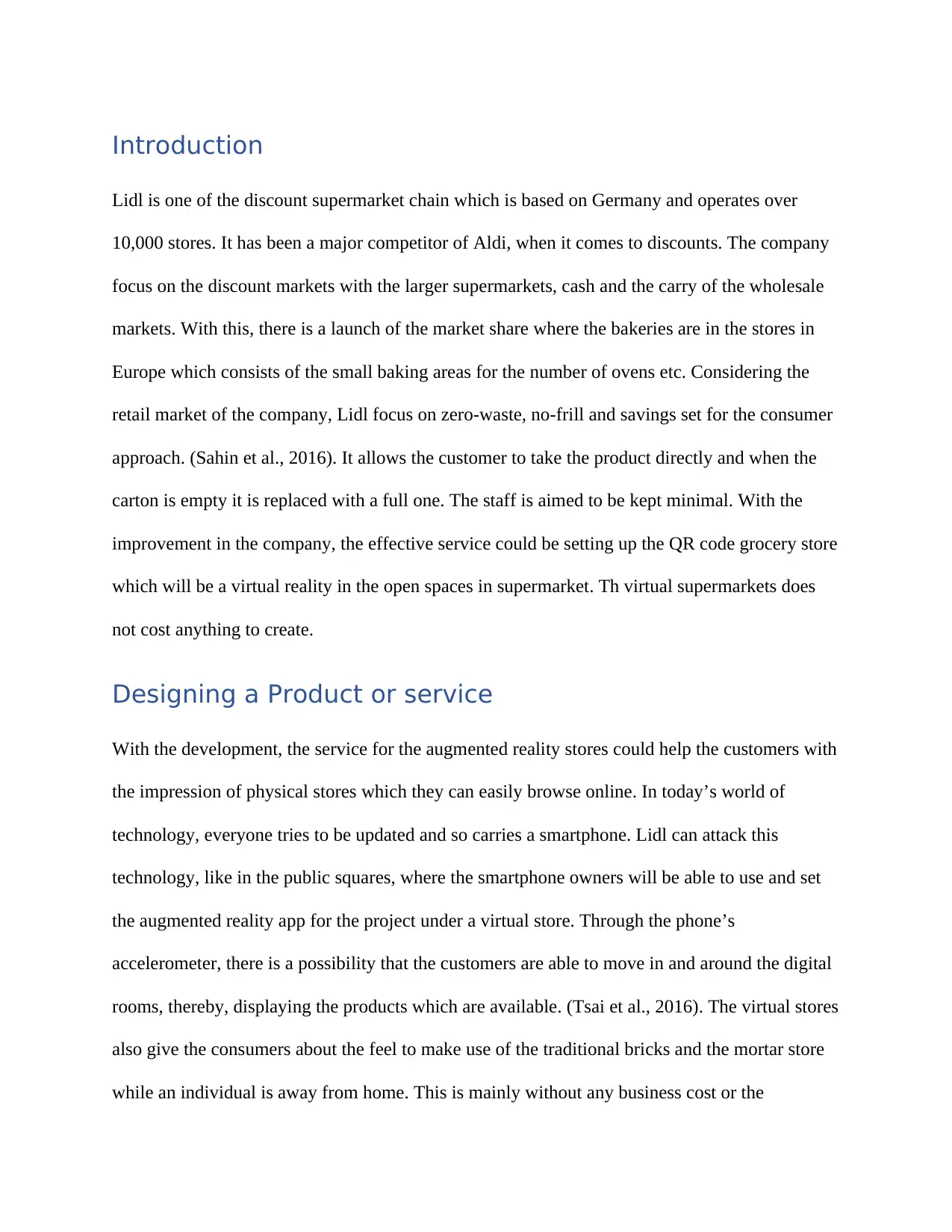
Introduction
Lidl is one of the discount supermarket chain which is based on Germany and operates over
10,000 stores. It has been a major competitor of Aldi, when it comes to discounts. The company
focus on the discount markets with the larger supermarkets, cash and the carry of the wholesale
markets. With this, there is a launch of the market share where the bakeries are in the stores in
Europe which consists of the small baking areas for the number of ovens etc. Considering the
retail market of the company, Lidl focus on zero-waste, no-frill and savings set for the consumer
approach. (Sahin et al., 2016). It allows the customer to take the product directly and when the
carton is empty it is replaced with a full one. The staff is aimed to be kept minimal. With the
improvement in the company, the effective service could be setting up the QR code grocery store
which will be a virtual reality in the open spaces in supermarket. Th virtual supermarkets does
not cost anything to create.
Designing a Product or service
With the development, the service for the augmented reality stores could help the customers with
the impression of physical stores which they can easily browse online. In today’s world of
technology, everyone tries to be updated and so carries a smartphone. Lidl can attack this
technology, like in the public squares, where the smartphone owners will be able to use and set
the augmented reality app for the project under a virtual store. Through the phone’s
accelerometer, there is a possibility that the customers are able to move in and around the digital
rooms, thereby, displaying the products which are available. (Tsai et al., 2016). The virtual stores
also give the consumers about the feel to make use of the traditional bricks and the mortar store
while an individual is away from home. This is mainly without any business cost or the
Lidl is one of the discount supermarket chain which is based on Germany and operates over
10,000 stores. It has been a major competitor of Aldi, when it comes to discounts. The company
focus on the discount markets with the larger supermarkets, cash and the carry of the wholesale
markets. With this, there is a launch of the market share where the bakeries are in the stores in
Europe which consists of the small baking areas for the number of ovens etc. Considering the
retail market of the company, Lidl focus on zero-waste, no-frill and savings set for the consumer
approach. (Sahin et al., 2016). It allows the customer to take the product directly and when the
carton is empty it is replaced with a full one. The staff is aimed to be kept minimal. With the
improvement in the company, the effective service could be setting up the QR code grocery store
which will be a virtual reality in the open spaces in supermarket. Th virtual supermarkets does
not cost anything to create.
Designing a Product or service
With the development, the service for the augmented reality stores could help the customers with
the impression of physical stores which they can easily browse online. In today’s world of
technology, everyone tries to be updated and so carries a smartphone. Lidl can attack this
technology, like in the public squares, where the smartphone owners will be able to use and set
the augmented reality app for the project under a virtual store. Through the phone’s
accelerometer, there is a possibility that the customers are able to move in and around the digital
rooms, thereby, displaying the products which are available. (Tsai et al., 2016). The virtual stores
also give the consumers about the feel to make use of the traditional bricks and the mortar store
while an individual is away from home. This is mainly without any business cost or the
⊘ This is a preview!⊘
Do you want full access?
Subscribe today to unlock all pages.

Trusted by 1+ million students worldwide
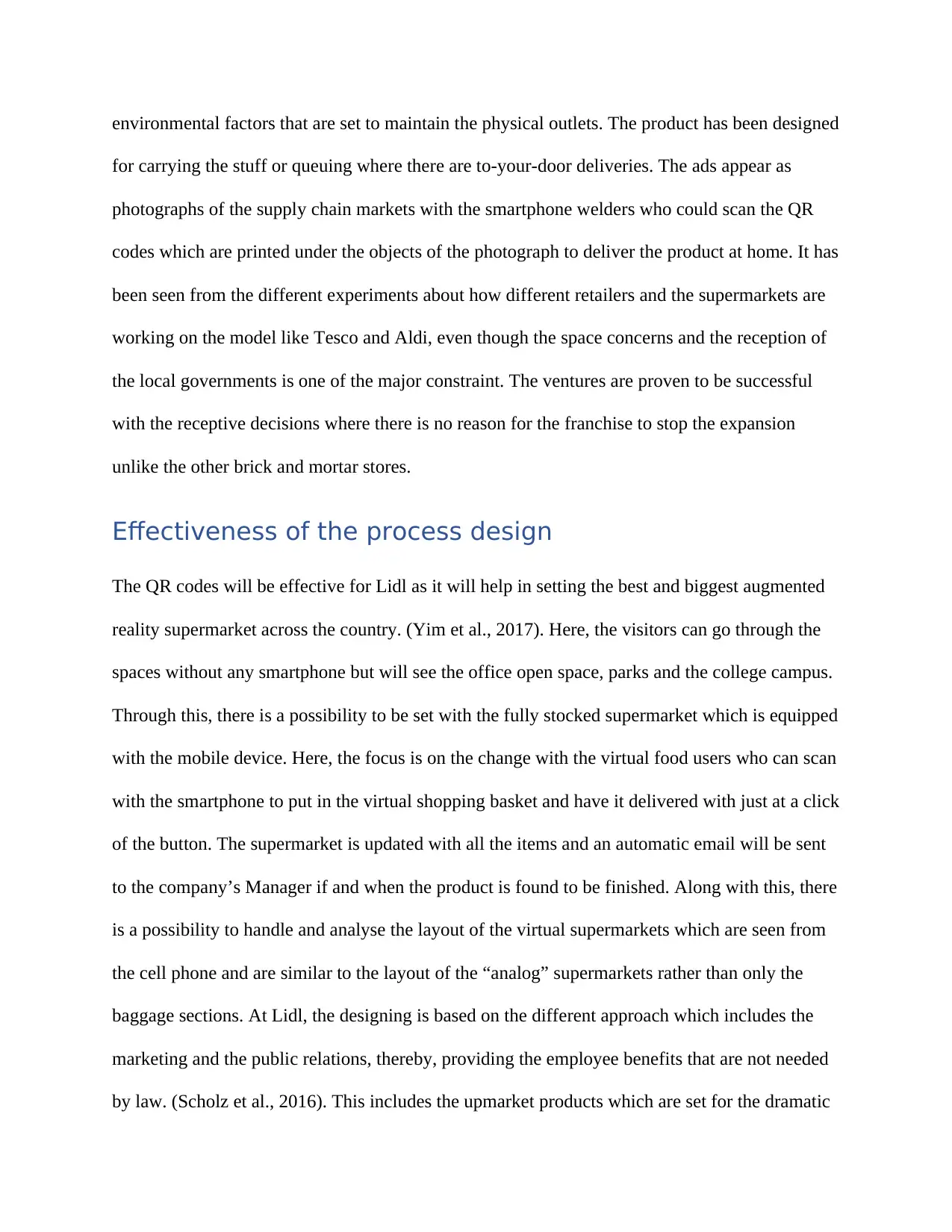
environmental factors that are set to maintain the physical outlets. The product has been designed
for carrying the stuff or queuing where there are to-your-door deliveries. The ads appear as
photographs of the supply chain markets with the smartphone welders who could scan the QR
codes which are printed under the objects of the photograph to deliver the product at home. It has
been seen from the different experiments about how different retailers and the supermarkets are
working on the model like Tesco and Aldi, even though the space concerns and the reception of
the local governments is one of the major constraint. The ventures are proven to be successful
with the receptive decisions where there is no reason for the franchise to stop the expansion
unlike the other brick and mortar stores.
Effectiveness of the process design
The QR codes will be effective for Lidl as it will help in setting the best and biggest augmented
reality supermarket across the country. (Yim et al., 2017). Here, the visitors can go through the
spaces without any smartphone but will see the office open space, parks and the college campus.
Through this, there is a possibility to be set with the fully stocked supermarket which is equipped
with the mobile device. Here, the focus is on the change with the virtual food users who can scan
with the smartphone to put in the virtual shopping basket and have it delivered with just at a click
of the button. The supermarket is updated with all the items and an automatic email will be sent
to the company’s Manager if and when the product is found to be finished. Along with this, there
is a possibility to handle and analyse the layout of the virtual supermarkets which are seen from
the cell phone and are similar to the layout of the “analog” supermarkets rather than only the
baggage sections. At Lidl, the designing is based on the different approach which includes the
marketing and the public relations, thereby, providing the employee benefits that are not needed
by law. (Scholz et al., 2016). This includes the upmarket products which are set for the dramatic
for carrying the stuff or queuing where there are to-your-door deliveries. The ads appear as
photographs of the supply chain markets with the smartphone welders who could scan the QR
codes which are printed under the objects of the photograph to deliver the product at home. It has
been seen from the different experiments about how different retailers and the supermarkets are
working on the model like Tesco and Aldi, even though the space concerns and the reception of
the local governments is one of the major constraint. The ventures are proven to be successful
with the receptive decisions where there is no reason for the franchise to stop the expansion
unlike the other brick and mortar stores.
Effectiveness of the process design
The QR codes will be effective for Lidl as it will help in setting the best and biggest augmented
reality supermarket across the country. (Yim et al., 2017). Here, the visitors can go through the
spaces without any smartphone but will see the office open space, parks and the college campus.
Through this, there is a possibility to be set with the fully stocked supermarket which is equipped
with the mobile device. Here, the focus is on the change with the virtual food users who can scan
with the smartphone to put in the virtual shopping basket and have it delivered with just at a click
of the button. The supermarket is updated with all the items and an automatic email will be sent
to the company’s Manager if and when the product is found to be finished. Along with this, there
is a possibility to handle and analyse the layout of the virtual supermarkets which are seen from
the cell phone and are similar to the layout of the “analog” supermarkets rather than only the
baggage sections. At Lidl, the designing is based on the different approach which includes the
marketing and the public relations, thereby, providing the employee benefits that are not needed
by law. (Scholz et al., 2016). This includes the upmarket products which are set for the dramatic
Paraphrase This Document
Need a fresh take? Get an instant paraphrase of this document with our AI Paraphraser
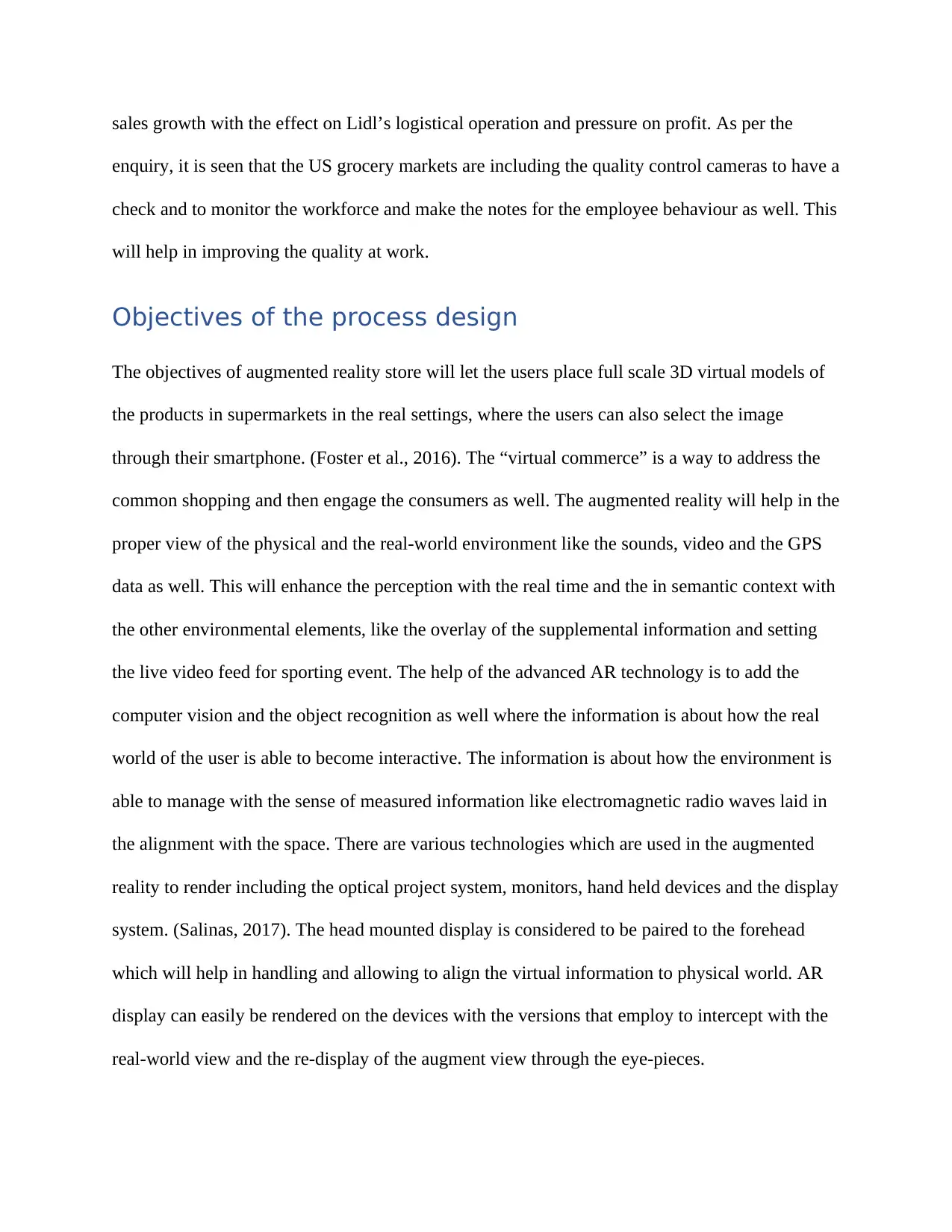
sales growth with the effect on Lidl’s logistical operation and pressure on profit. As per the
enquiry, it is seen that the US grocery markets are including the quality control cameras to have a
check and to monitor the workforce and make the notes for the employee behaviour as well. This
will help in improving the quality at work.
Objectives of the process design
The objectives of augmented reality store will let the users place full scale 3D virtual models of
the products in supermarkets in the real settings, where the users can also select the image
through their smartphone. (Foster et al., 2016). The “virtual commerce” is a way to address the
common shopping and then engage the consumers as well. The augmented reality will help in the
proper view of the physical and the real-world environment like the sounds, video and the GPS
data as well. This will enhance the perception with the real time and the in semantic context with
the other environmental elements, like the overlay of the supplemental information and setting
the live video feed for sporting event. The help of the advanced AR technology is to add the
computer vision and the object recognition as well where the information is about how the real
world of the user is able to become interactive. The information is about how the environment is
able to manage with the sense of measured information like electromagnetic radio waves laid in
the alignment with the space. There are various technologies which are used in the augmented
reality to render including the optical project system, monitors, hand held devices and the display
system. (Salinas, 2017). The head mounted display is considered to be paired to the forehead
which will help in handling and allowing to align the virtual information to physical world. AR
display can easily be rendered on the devices with the versions that employ to intercept with the
real-world view and the re-display of the augment view through the eye-pieces.
enquiry, it is seen that the US grocery markets are including the quality control cameras to have a
check and to monitor the workforce and make the notes for the employee behaviour as well. This
will help in improving the quality at work.
Objectives of the process design
The objectives of augmented reality store will let the users place full scale 3D virtual models of
the products in supermarkets in the real settings, where the users can also select the image
through their smartphone. (Foster et al., 2016). The “virtual commerce” is a way to address the
common shopping and then engage the consumers as well. The augmented reality will help in the
proper view of the physical and the real-world environment like the sounds, video and the GPS
data as well. This will enhance the perception with the real time and the in semantic context with
the other environmental elements, like the overlay of the supplemental information and setting
the live video feed for sporting event. The help of the advanced AR technology is to add the
computer vision and the object recognition as well where the information is about how the real
world of the user is able to become interactive. The information is about how the environment is
able to manage with the sense of measured information like electromagnetic radio waves laid in
the alignment with the space. There are various technologies which are used in the augmented
reality to render including the optical project system, monitors, hand held devices and the display
system. (Salinas, 2017). The head mounted display is considered to be paired to the forehead
which will help in handling and allowing to align the virtual information to physical world. AR
display can easily be rendered on the devices with the versions that employ to intercept with the
real-world view and the re-display of the augment view through the eye-pieces.
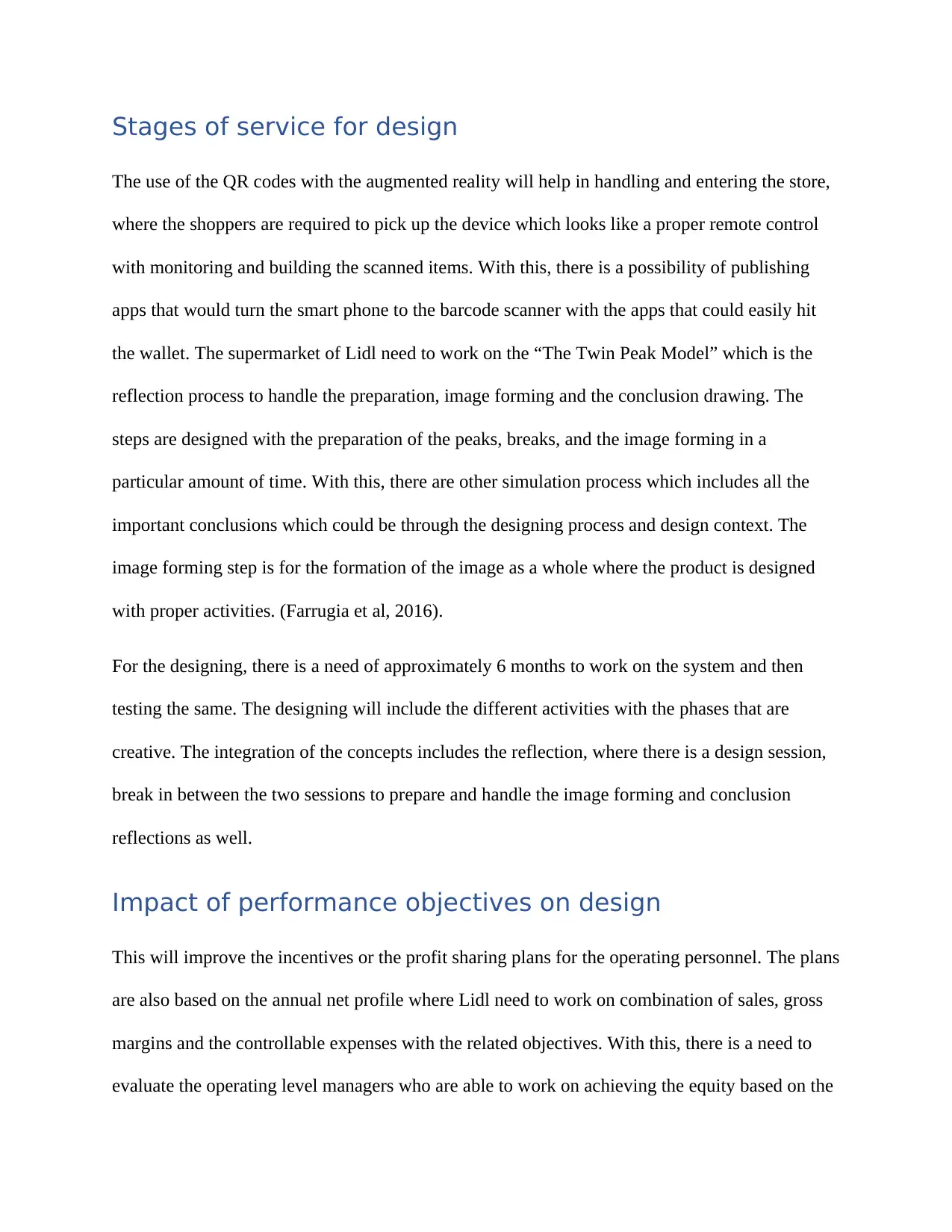
Stages of service for design
The use of the QR codes with the augmented reality will help in handling and entering the store,
where the shoppers are required to pick up the device which looks like a proper remote control
with monitoring and building the scanned items. With this, there is a possibility of publishing
apps that would turn the smart phone to the barcode scanner with the apps that could easily hit
the wallet. The supermarket of Lidl need to work on the “The Twin Peak Model” which is the
reflection process to handle the preparation, image forming and the conclusion drawing. The
steps are designed with the preparation of the peaks, breaks, and the image forming in a
particular amount of time. With this, there are other simulation process which includes all the
important conclusions which could be through the designing process and design context. The
image forming step is for the formation of the image as a whole where the product is designed
with proper activities. (Farrugia et al, 2016).
For the designing, there is a need of approximately 6 months to work on the system and then
testing the same. The designing will include the different activities with the phases that are
creative. The integration of the concepts includes the reflection, where there is a design session,
break in between the two sessions to prepare and handle the image forming and conclusion
reflections as well.
Impact of performance objectives on design
This will improve the incentives or the profit sharing plans for the operating personnel. The plans
are also based on the annual net profile where Lidl need to work on combination of sales, gross
margins and the controllable expenses with the related objectives. With this, there is a need to
evaluate the operating level managers who are able to work on achieving the equity based on the
The use of the QR codes with the augmented reality will help in handling and entering the store,
where the shoppers are required to pick up the device which looks like a proper remote control
with monitoring and building the scanned items. With this, there is a possibility of publishing
apps that would turn the smart phone to the barcode scanner with the apps that could easily hit
the wallet. The supermarket of Lidl need to work on the “The Twin Peak Model” which is the
reflection process to handle the preparation, image forming and the conclusion drawing. The
steps are designed with the preparation of the peaks, breaks, and the image forming in a
particular amount of time. With this, there are other simulation process which includes all the
important conclusions which could be through the designing process and design context. The
image forming step is for the formation of the image as a whole where the product is designed
with proper activities. (Farrugia et al, 2016).
For the designing, there is a need of approximately 6 months to work on the system and then
testing the same. The designing will include the different activities with the phases that are
creative. The integration of the concepts includes the reflection, where there is a design session,
break in between the two sessions to prepare and handle the image forming and conclusion
reflections as well.
Impact of performance objectives on design
This will improve the incentives or the profit sharing plans for the operating personnel. The plans
are also based on the annual net profile where Lidl need to work on combination of sales, gross
margins and the controllable expenses with the related objectives. With this, there is a need to
evaluate the operating level managers who are able to work on achieving the equity based on the
⊘ This is a preview!⊘
Do you want full access?
Subscribe today to unlock all pages.

Trusted by 1+ million students worldwide
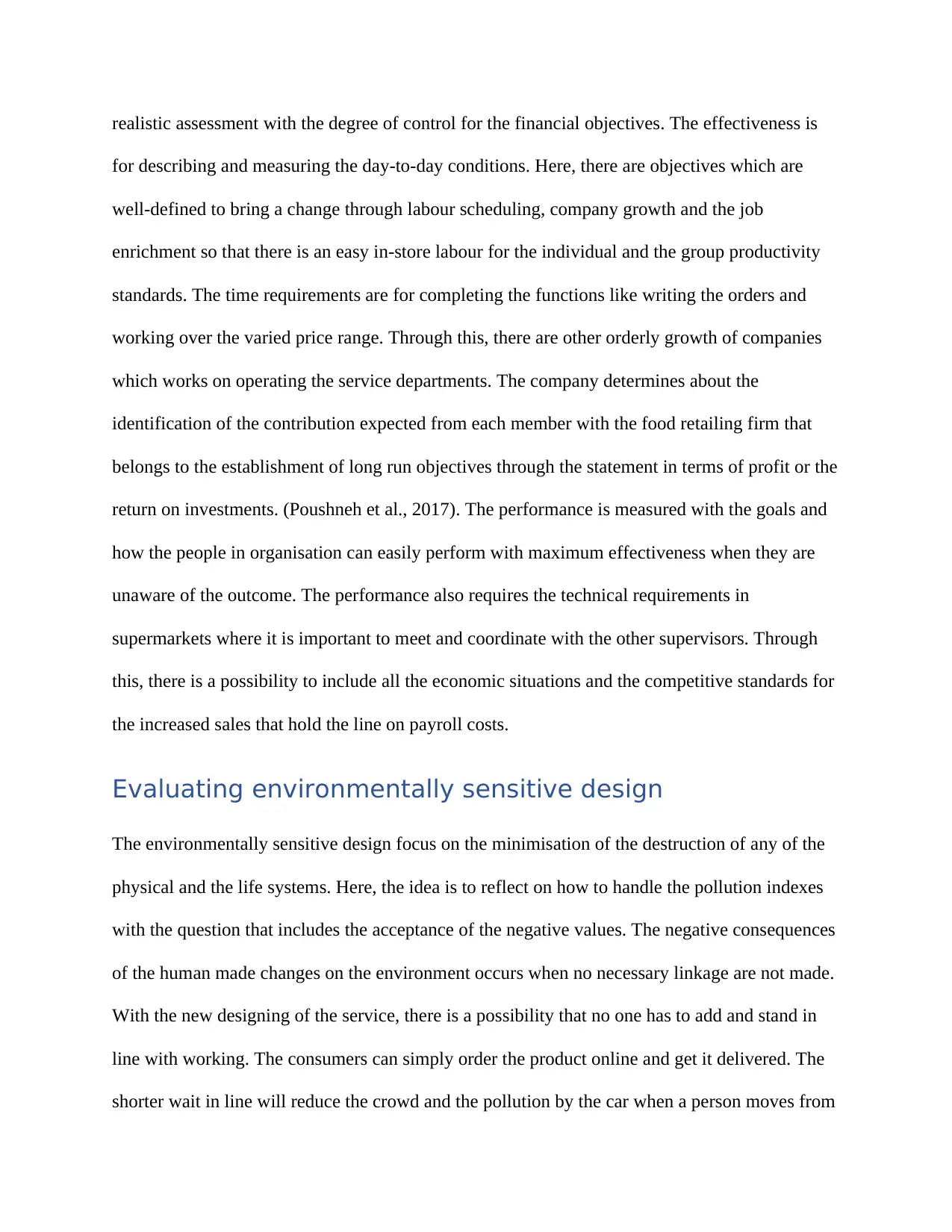
realistic assessment with the degree of control for the financial objectives. The effectiveness is
for describing and measuring the day-to-day conditions. Here, there are objectives which are
well-defined to bring a change through labour scheduling, company growth and the job
enrichment so that there is an easy in-store labour for the individual and the group productivity
standards. The time requirements are for completing the functions like writing the orders and
working over the varied price range. Through this, there are other orderly growth of companies
which works on operating the service departments. The company determines about the
identification of the contribution expected from each member with the food retailing firm that
belongs to the establishment of long run objectives through the statement in terms of profit or the
return on investments. (Poushneh et al., 2017). The performance is measured with the goals and
how the people in organisation can easily perform with maximum effectiveness when they are
unaware of the outcome. The performance also requires the technical requirements in
supermarkets where it is important to meet and coordinate with the other supervisors. Through
this, there is a possibility to include all the economic situations and the competitive standards for
the increased sales that hold the line on payroll costs.
Evaluating environmentally sensitive design
The environmentally sensitive design focus on the minimisation of the destruction of any of the
physical and the life systems. Here, the idea is to reflect on how to handle the pollution indexes
with the question that includes the acceptance of the negative values. The negative consequences
of the human made changes on the environment occurs when no necessary linkage are not made.
With the new designing of the service, there is a possibility that no one has to add and stand in
line with working. The consumers can simply order the product online and get it delivered. The
shorter wait in line will reduce the crowd and the pollution by the car when a person moves from
for describing and measuring the day-to-day conditions. Here, there are objectives which are
well-defined to bring a change through labour scheduling, company growth and the job
enrichment so that there is an easy in-store labour for the individual and the group productivity
standards. The time requirements are for completing the functions like writing the orders and
working over the varied price range. Through this, there are other orderly growth of companies
which works on operating the service departments. The company determines about the
identification of the contribution expected from each member with the food retailing firm that
belongs to the establishment of long run objectives through the statement in terms of profit or the
return on investments. (Poushneh et al., 2017). The performance is measured with the goals and
how the people in organisation can easily perform with maximum effectiveness when they are
unaware of the outcome. The performance also requires the technical requirements in
supermarkets where it is important to meet and coordinate with the other supervisors. Through
this, there is a possibility to include all the economic situations and the competitive standards for
the increased sales that hold the line on payroll costs.
Evaluating environmentally sensitive design
The environmentally sensitive design focus on the minimisation of the destruction of any of the
physical and the life systems. Here, the idea is to reflect on how to handle the pollution indexes
with the question that includes the acceptance of the negative values. The negative consequences
of the human made changes on the environment occurs when no necessary linkage are not made.
With the new designing of the service, there is a possibility that no one has to add and stand in
line with working. The consumers can simply order the product online and get it delivered. The
shorter wait in line will reduce the crowd and the pollution by the car when a person moves from
Paraphrase This Document
Need a fresh take? Get an instant paraphrase of this document with our AI Paraphraser
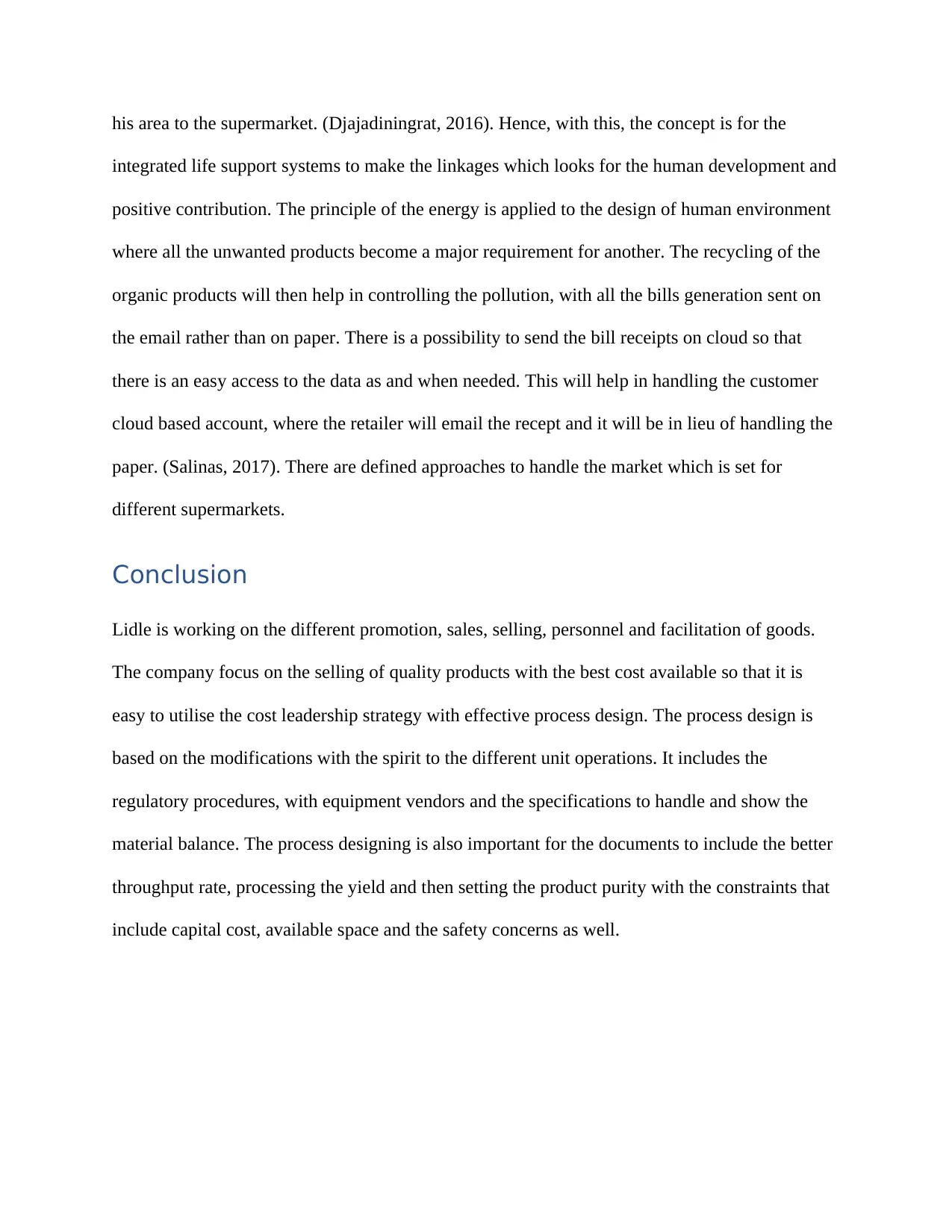
his area to the supermarket. (Djajadiningrat, 2016). Hence, with this, the concept is for the
integrated life support systems to make the linkages which looks for the human development and
positive contribution. The principle of the energy is applied to the design of human environment
where all the unwanted products become a major requirement for another. The recycling of the
organic products will then help in controlling the pollution, with all the bills generation sent on
the email rather than on paper. There is a possibility to send the bill receipts on cloud so that
there is an easy access to the data as and when needed. This will help in handling the customer
cloud based account, where the retailer will email the recept and it will be in lieu of handling the
paper. (Salinas, 2017). There are defined approaches to handle the market which is set for
different supermarkets.
Conclusion
Lidle is working on the different promotion, sales, selling, personnel and facilitation of goods.
The company focus on the selling of quality products with the best cost available so that it is
easy to utilise the cost leadership strategy with effective process design. The process design is
based on the modifications with the spirit to the different unit operations. It includes the
regulatory procedures, with equipment vendors and the specifications to handle and show the
material balance. The process designing is also important for the documents to include the better
throughput rate, processing the yield and then setting the product purity with the constraints that
include capital cost, available space and the safety concerns as well.
integrated life support systems to make the linkages which looks for the human development and
positive contribution. The principle of the energy is applied to the design of human environment
where all the unwanted products become a major requirement for another. The recycling of the
organic products will then help in controlling the pollution, with all the bills generation sent on
the email rather than on paper. There is a possibility to send the bill receipts on cloud so that
there is an easy access to the data as and when needed. This will help in handling the customer
cloud based account, where the retailer will email the recept and it will be in lieu of handling the
paper. (Salinas, 2017). There are defined approaches to handle the market which is set for
different supermarkets.
Conclusion
Lidle is working on the different promotion, sales, selling, personnel and facilitation of goods.
The company focus on the selling of quality products with the best cost available so that it is
easy to utilise the cost leadership strategy with effective process design. The process design is
based on the modifications with the spirit to the different unit operations. It includes the
regulatory procedures, with equipment vendors and the specifications to handle and show the
material balance. The process designing is also important for the documents to include the better
throughput rate, processing the yield and then setting the product purity with the constraints that
include capital cost, available space and the safety concerns as well.
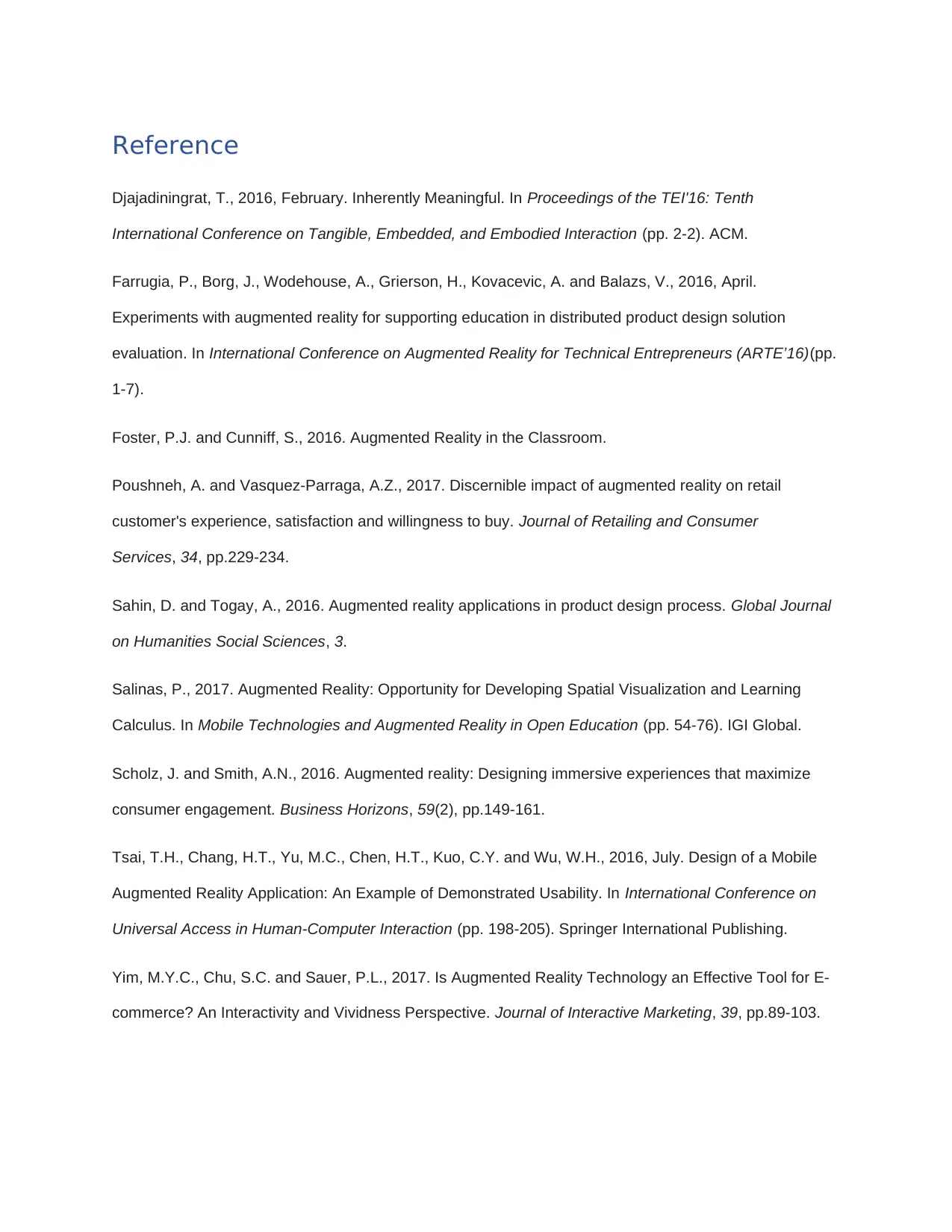
Reference
Djajadiningrat, T., 2016, February. Inherently Meaningful. In Proceedings of the TEI'16: Tenth
International Conference on Tangible, Embedded, and Embodied Interaction (pp. 2-2). ACM.
Farrugia, P., Borg, J., Wodehouse, A., Grierson, H., Kovacevic, A. and Balazs, V., 2016, April.
Experiments with augmented reality for supporting education in distributed product design solution
evaluation. In International Conference on Augmented Reality for Technical Entrepreneurs (ARTE’16)(pp.
1-7).
Foster, P.J. and Cunniff, S., 2016. Augmented Reality in the Classroom.
Poushneh, A. and Vasquez-Parraga, A.Z., 2017. Discernible impact of augmented reality on retail
customer's experience, satisfaction and willingness to buy. Journal of Retailing and Consumer
Services, 34, pp.229-234.
Sahin, D. and Togay, A., 2016. Augmented reality applications in product design process. Global Journal
on Humanities Social Sciences, 3.
Salinas, P., 2017. Augmented Reality: Opportunity for Developing Spatial Visualization and Learning
Calculus. In Mobile Technologies and Augmented Reality in Open Education (pp. 54-76). IGI Global.
Scholz, J. and Smith, A.N., 2016. Augmented reality: Designing immersive experiences that maximize
consumer engagement. Business Horizons, 59(2), pp.149-161.
Tsai, T.H., Chang, H.T., Yu, M.C., Chen, H.T., Kuo, C.Y. and Wu, W.H., 2016, July. Design of a Mobile
Augmented Reality Application: An Example of Demonstrated Usability. In International Conference on
Universal Access in Human-Computer Interaction (pp. 198-205). Springer International Publishing.
Yim, M.Y.C., Chu, S.C. and Sauer, P.L., 2017. Is Augmented Reality Technology an Effective Tool for E-
commerce? An Interactivity and Vividness Perspective. Journal of Interactive Marketing, 39, pp.89-103.
Djajadiningrat, T., 2016, February. Inherently Meaningful. In Proceedings of the TEI'16: Tenth
International Conference on Tangible, Embedded, and Embodied Interaction (pp. 2-2). ACM.
Farrugia, P., Borg, J., Wodehouse, A., Grierson, H., Kovacevic, A. and Balazs, V., 2016, April.
Experiments with augmented reality for supporting education in distributed product design solution
evaluation. In International Conference on Augmented Reality for Technical Entrepreneurs (ARTE’16)(pp.
1-7).
Foster, P.J. and Cunniff, S., 2016. Augmented Reality in the Classroom.
Poushneh, A. and Vasquez-Parraga, A.Z., 2017. Discernible impact of augmented reality on retail
customer's experience, satisfaction and willingness to buy. Journal of Retailing and Consumer
Services, 34, pp.229-234.
Sahin, D. and Togay, A., 2016. Augmented reality applications in product design process. Global Journal
on Humanities Social Sciences, 3.
Salinas, P., 2017. Augmented Reality: Opportunity for Developing Spatial Visualization and Learning
Calculus. In Mobile Technologies and Augmented Reality in Open Education (pp. 54-76). IGI Global.
Scholz, J. and Smith, A.N., 2016. Augmented reality: Designing immersive experiences that maximize
consumer engagement. Business Horizons, 59(2), pp.149-161.
Tsai, T.H., Chang, H.T., Yu, M.C., Chen, H.T., Kuo, C.Y. and Wu, W.H., 2016, July. Design of a Mobile
Augmented Reality Application: An Example of Demonstrated Usability. In International Conference on
Universal Access in Human-Computer Interaction (pp. 198-205). Springer International Publishing.
Yim, M.Y.C., Chu, S.C. and Sauer, P.L., 2017. Is Augmented Reality Technology an Effective Tool for E-
commerce? An Interactivity and Vividness Perspective. Journal of Interactive Marketing, 39, pp.89-103.
⊘ This is a preview!⊘
Do you want full access?
Subscribe today to unlock all pages.

Trusted by 1+ million students worldwide
1 out of 9
Related Documents
Your All-in-One AI-Powered Toolkit for Academic Success.
+13062052269
info@desklib.com
Available 24*7 on WhatsApp / Email
![[object Object]](/_next/static/media/star-bottom.7253800d.svg)
Unlock your academic potential
Copyright © 2020–2025 A2Z Services. All Rights Reserved. Developed and managed by ZUCOL.





